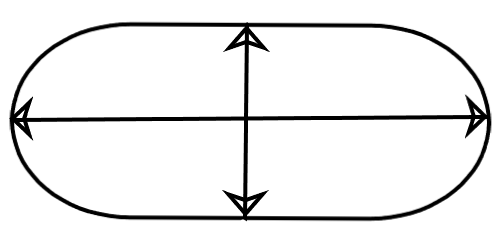
Cell constant of a conductivity cell is:
(A)
(B)
(C)
(D)
Answer
142.5k+ views
Hint: Cell constant of a cell can be derived from both resistance and conductance. The right answer in this case includes specific conductance and conductance.
Complete step-by-step answer:
Let’s start with understanding the concept of cell constant. You must already know from your lessons in physics that resistance of a material is related to its length, area of cross-section and nature. Same theory applies to chemical solutions. But it has some differences. Such as how would you define the length and area of the cross section of a solution?
To overcome these problems, these ionic solutions are taken inside things known as conductivity cells (as represented below). These are actually tubular structures with the horizontal line referring to its length and the vertical line as its area of cross section. Now the calculations become easier.

The resistance (R) is equal to:
Where “
This makes the equation of resistance as:
And therefore cell constant is also equal to:
That is, cell constant is the ratio between resistance and specific resistance or resistivity. But the options do not include this.
Let us take this chance to define conductance. As its name suggests, it is opposite to that of resistance and is mathematically the reciprocal of resistance. It is represented as
The quantity “
And as cell constant is the ratio of length and area, we can get another expression by rearranging the above equation, as:
Now the cell constant has a new definition. It can be defined as the ratio between specific conductance or conductivity and conductance, as:
Therefore the answer is option (C)
Note: The IUPAC has recommended the use of resistivity in place of specific resistance and conductivity in place of specific conductance. But these terms are still interchanged in some places.
Cell constant is an important parameter in defining molar conductivity of diluted solutions.
Complete step-by-step answer:
Let’s start with understanding the concept of cell constant. You must already know from your lessons in physics that resistance of a material is related to its length, area of cross-section and nature. Same theory applies to chemical solutions. But it has some differences. Such as how would you define the length and area of the cross section of a solution?
To overcome these problems, these ionic solutions are taken inside things known as conductivity cells (as represented below). These are actually tubular structures with the horizontal line referring to its length and the vertical line as its area of cross section. Now the calculations become easier.

The resistance (R) is equal to:
Where “
This makes the equation of resistance as:
And therefore cell constant is also equal to:
That is, cell constant is the ratio between resistance and specific resistance or resistivity. But the options do not include this.
Let us take this chance to define conductance. As its name suggests, it is opposite to that of resistance and is mathematically the reciprocal of resistance. It is represented as
The quantity “
And as cell constant is the ratio of length and area, we can get another expression by rearranging the above equation, as:
Now the cell constant has a new definition. It can be defined as the ratio between specific conductance or conductivity and conductance, as:
Therefore the answer is option (C)
Note: The IUPAC has recommended the use of resistivity in place of specific resistance and conductivity in place of specific conductance. But these terms are still interchanged in some places.
Cell constant is an important parameter in defining molar conductivity of diluted solutions.
Latest Vedantu courses for you
Grade 11 Science PCM | CBSE | SCHOOL | English
CBSE (2025-26)
School Full course for CBSE students
₹41,848 per year
EMI starts from ₹3,487.34 per month
Recently Updated Pages
How to find Oxidation Number - Important Concepts for JEE

How Electromagnetic Waves are Formed - Important Concepts for JEE

Electrical Resistance - Important Concepts and Tips for JEE

Average Atomic Mass - Important Concepts and Tips for JEE

Chemical Equation - Important Concepts and Tips for JEE

Concept of CP and CV of Gas - Important Concepts and Tips for JEE

Trending doubts
JEE Main 2025 Session 2: Application Form (Out), Exam Dates (Released), Eligibility, & More

JEE Main Exam Marking Scheme: Detailed Breakdown of Marks and Negative Marking

JEE Main 2025: Derivation of Equation of Trajectory in Physics

Electric Field Due to Uniformly Charged Ring for JEE Main 2025 - Formula and Derivation

Types of Solutions

Degree of Dissociation and Its Formula With Solved Example for JEE

Other Pages
NCERT Solutions for Class 12 Chemistry Chapter 6 Haloalkanes and Haloarenes

NCERT Solutions for Class 12 Chemistry Chapter 2 Electrochemistry

NCERT Solutions for Class 12 Chemistry Chapter 7 Alcohol Phenol and Ether

NCERT Solutions for Class 12 Chemistry Chapter 1 Solutions

Solutions Class 12 Notes: CBSE Chemistry Chapter 1

JEE Advanced Marks vs Ranks 2025: Understanding Category-wise Qualifying Marks and Previous Year Cut-offs




